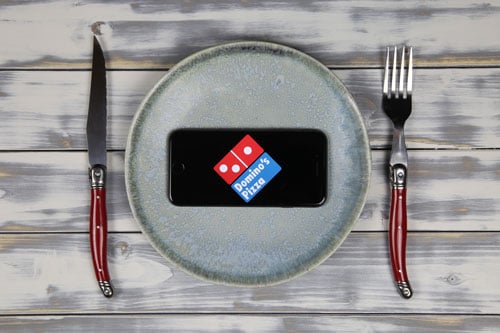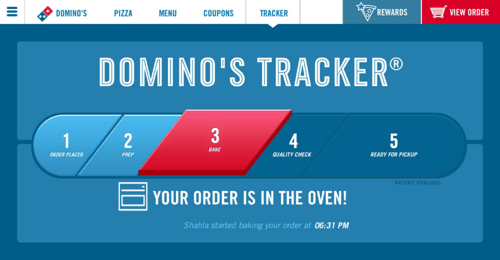How the Domino’s Pizza Tracker Changed Consumer Expectations

Believe it or not, consumers and realtors work with other companies in industries other than the title and escrow industry.
… I know… crazy to think, right!?
The way everyone views customer experience has been molded by these experiences with companies outside of the land title industry. And call it a blessing or curse, the consumers’, realtors’, and lenders’ expectations for the settlement process have forever been changed by these outside industries.
In this blog series, we’re going to dive into 7 companies that have shaped the consumer experience and how they’ve impacted the title and escrow industry.
There are 3 things that all these companies offer and I call them the QCCs:
1- Quality product or service. This relates with your brand promise and what customers expect when they decide to work with you; how consistent you are with what you promise and the quality of what you produce (i.e., when you order a Caramel Frappuccino at a Starbucks in Tallahassee, FL, it will taste the same as if you order it in Madison, WI.)
2- Customer care. Companies that set the bar in their industries will display proactive customer care instead of reactive customer service.
3- Customer control. This means making sure the customer knows what has happened, what is happening, and what will happen next. It also means the customer does not feel like things are happening to them, but instead, for them.
Having a quality product or service is the first and most important step though.
If a company does not offer quality products or services, then something is wrong and that company should work on their internal processes and systems to assure they can actually check this off.
For that reason, we won’t spend much time on the high quality that each of these companies offers. Instead, in this blog series, we will focus primarily on how these 7 companies offer customers more control, which improves their overall customer experience.
For the first blog in this series, we’re talking about Domino’s Pizza.

Remember growing up ordering pizza on a Friday night?
You’d call the pizza place and wait for the delivery guy to arrive at your house.
There was even one pizza place that offered a time guarantee: if the pizza didn’t arrive in 30 minutes or less, it was free. All anyone could do for those 30 minutes was watch the clock while the anticipation and your hunger grew.
There was no way to track the status of your pizza.
Everyone was left in the dark - clueless and without any control.
Over time, delivery pizza places started using warming bags to keep the pizzas hot and offering coupons and deals.
Then Domino’s came out with their pizza tracker and completely changed the pizza landscape. Here’s what they DIDN’T do though:
- Domino’s didn’t offer a money-back guarantee.
- Domino’s didn’t offer free breadsticks
- Domino’s didn’t guarantee that the pizza would stay warm.
What did Domino’s do?
Domino’s allowed the consumer to know the status of their pizza - to watch it being made and sent out for delivery. This gave customers CONTROL.
Domino’s allowed consumers to be kept informed - and that was enough to set them apart in a very crowded and commoditized industry.

When Domino’s came out with their famous pizza tracker over a decade ago, they completely changed the expectations placed on companies during any type of transaction.
Today, if a company cannot provide an update as to the status of an order, the consumer’s anxiety goes up because they feel like they have no control over the situation. Because of this lack of control, they’ll take their business to the companies that can provide updates.
Take-aways for Title and Escrow Companies
What Domino’s did was allow consumers to know three things:
1. Where they’ve been.
2. Where they are.
3. Where they’re going next.
Ultimately this gives consumers control.
In previous posts, we’ve talked about the difference between care and service. Service is when the consumer just orders the pizza and waits for it to be delivered.
Care, on the other hand, raises the bar.
Care allows the consumer to order the pizza, choose the toppings, watch the pizza being made, and know when it’s out for delivery so they know when to set the table and give their kids a 5-minute warning before they have to turn off their video games.
What does this mean for title?
This means realtors and consumers have an expectation of knowing the status of their closing. A simple text message or email update can do the trick. Whether or not the next title company offers this type of insight into the closing process shouldn’t matter.
The company that does offer this care by putting control in the hands of clients will attract more real estate agents and consumers.

In the title industry, visual status updates--“pizza trackers” for title--let clients know the status of their closing at every step in the process. Visual updates are valuable because “our brains can process visuals up to 60,000 times faster than text.”
Yes, you read that right!
60,000 times faster!
What could that mean for your clients?
At CloseSimple, we’ve identified the 5 steps that every title company takes in the closing process. You can download our PDF here or check out our post on the 5 Most-Used Email/Text Templates. All these steps can be customized for your company to include your brand, your logo, etc. It also includes text message updates for each step.
![]()
Because CloseSimple seamlessly integrates to your title production software, when your team works on a file, these milestone updates can be sent directly to consumers, realtors, and lenders.
If Domino’s can update the consumer about the status of their pizza from the dough being flattened, to the sauce being spread, the toppings being added, and the pizza being placed in the oven, why shouldn't a consumer and realtor know that you got their file, that you’re working on it, and when and where the closing will be?
Let CloseSimple help you look amazing by helping you provide your clients with a stronger sense of control with visual updates, ultimately offering them excellent customer care.
bogid - 27787114388
Related posts

Article
Jimmy John’s: Freaky Fast & Impacting How Your Clients View the Closing

Email Efficiency
What Amazon’s Customer Experience Means for the Title & Escrow Industry

Article
How Uber Gave Customers Control & Why Title Should Take Notice

Article
Uber, Dominos, + 5-Step Streamlined Communication in Title